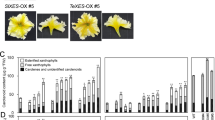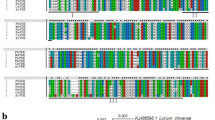Abstract
Oxycarotenoids, produced through the oxidation of carotenoids, play critical roles in plants. This reaction is mediated by a specific enzyme, β;-carotene hydroxylase, which adds hydroxyl groups to the β;-rings of carotenes. To investigate the effect of the β;-carotene hydroxylase gene (Chyb) on oxycarotenoid biosynthesis, we generated transgenicArabidopsis plants that over-expressedChyb under the control of a 35S promoter. Their levels of zeaxanthin and neoxanthin were two- to three-fold greater relative to the WT, while that of violaxanthin, a final product in the xanlthophyll pathway, was 1.3-fold higher than the control. In contrast, the amount of β;-carotene declined as much as 2.4-fold, depending on the particular transgenic line. Interestingly, astaxanthin was produced in the transgenics, but not in the WT. These data suggest that, with the aid of unknown factors in the host, carotenoids could be converted into metabolites in the astaxanthin biosynthetic pathway. Microarray analysis was used lo identify several genes that were consistently up-or down-regulated in transgenic chyB leaves compared with the controls. Here, we also discuss possible modifications in leaf carotenoids, and the importance of these data from a nutritional standpoint.
Similar content being viewed by others
Literature Cited
Armstrong G (l994) Eubactena show their true colors: Genetics of carotenoid pigment biosynlhesis from microbes to plants. Journal of Bacteriology176(16): 4795–4802
Breitenbach J, Misawa N, Kajiwara S, Sandmann G (1996) Expression inEscherichia coli and properties of the carotene ketolase fromHaematococcus pluvalis. FEMS Microbiol Lett140: 241–246
Clough SJ, Bent AF (1998) Floral clip: A simplified method for Agrobacterium-mediated transformation ofArabidopsis thaliana.. Plant J16: 735–743
Cunningham FX Jr, Gantt E (1998) Genes and enzymes of carotenoid biosynthesis on plants. Annu Rev Plant Physiol Plant Mol Biol49: 557–583
Davison PA, Hunter CN, Horton P (2002) Overexpression of betacarotene hyclroxylase enhances stress tolerance inArabidopsis. Nature418: 203–206
Desfeux C, Clough SJ, Bent AF (2000) Female reproductive tissues are the primary target of Agrobacterium-mecliated transformation by theArabidopsis floral-clip method. Plant Physiol123: 895–904
Fraser PD, Bramley PM (2004) The biosynthesis and nutritional uses cf carotenoids. Prog Lipicl Res43: 228–265
Fraser PD, Romer S, Shipton CA, Mills PB, Kiano JW, Misawa N, Drake RG, Schuch W, Bramley PM (2002) Evaluation of transgenic tomato plants expressing an additional phytoene synthase in a fruit-specific manner. Proc Natl Acad Sci USA99:1092–1097
Gann PH, Khachik F (2003) Tomatoes or lycopene versus prostate cancer: Is evolution anti-reductionist. J Natl Cancer Inst95: 1563–1565
Harker M, Hirschberg J (1997) Biosynthesis of ketocarotenoids in transgenic cyanobacteria expressing the algal gene for beta-C-4-oxygenase, crtO. FEBS Lett404: 129–134
Hart DJ, Scott KJ (1995) Development and evaluation of an HPLC method for the analysis of carotenoids in foods, and the measurement of the carotenoid content of vegetables and fruits commonly consumed in the UK. Food Chem54: 101–111
Hauptmann R, Eschenfeldt WH, English J, Brinkhaus FL (1997) Enhanced carotenoid accumulation in storage organs of genetically engineered plants. US Patent 5618–988
Havaux M (1998) Carotenoids as membrane stabilizers in chloroplasts. Trends Plant Sci3: 147–151
Hirschberg J (2001) Carotenoicl biosynthesis in flowering plants. Curr Opin Plant Biol4: 210–218
Hirschberg J, Cohen M, Harker M, Lotan T, Mann V, Pecker I (1997) Molecular genetics of the carotenoicl biosynthesis pathway in plants and algae. Pure Appl Chem69: 2151–2158
Hughes TR, Mao M, Jones AR, Burchard J, Linsley PS (2001) Expression profiling using microarrays fabricated by an ink-jet oligonucleotide synthesizer. Nat Biotechnol19: 342–347
Krinsky NI (1989) Carotenoids and cancer in animal models. J Nutr119: 123–126
Krinsky NI, Landrum JT, Bone RA (2003) Biologic mechanisms of the protective role of lutein and zeaxanthin in the eye. Annu. Rev. Nutr.23: 171–201
Lindgren L, Stålberg KG, Högluncl AS (2003) Seed-specific overex-pression of an endogenousArabidopsis phytoene synthase gene results in delayed germination and increased levels of carotenoids, chlorophyll, and abscisic acid. Plant Physiology132: 779–785
Lotan T, Hirschberg J (1995) Cloning and expression inEscherichia coli of the gene encoding beta-C-4-oxygenase, that convert; beta-carotene to the ketocarotenoid canthaxanthin inHaematococcus pluvialis. FEBS Lett364: 125–128
Mann V, Harker M, Pecker I, Hirschberg J (2000) Metabolic engineering of astaxanthin production in tobacco flowers. Nat Biotechnol18: 888–892
Marrs B (1981) Mobilization of the genes for photosynthesis fromRhodopseudomonas capsulate by a promiscuous plasmid. J Bacteriol146: 1003–1012
Melèndez-Martínez AJ, Britton G, Vicario IM, Heredia FJ (2005a) Identification of zeinoxanthin in orange juices. J Agric Food Chem53: 6362–6367
Melèndez-Martìnez AJ, Britton G, Vicario IM, Heredia-Mira FJ (2005b) Color and carotenoicl profile of Spanish Valencia late ultrafrozen orange juices. Food Res Intl38: 931–936
Misawa N, Nakagawa M, Kobayashi K, Yamano S, Izawa Y, Nakamura K, Harashima K (1990) Elucidation of theErwinia uredovora carotenoid biosynthetic pathway by functional analysis of the gene products expressed inE. coli. J Bacteriol172: 6704–6712
Mitsuhara I, Ugaki M, Horochika H (1996) Efficient promoter cassettes for enhanced expression of foreign genes in dicotyledonous and monocotyledonous plants. Plant Cell Physiol37: 49–59
Mouly PP, Gaydou EM, Corsetti J (1999) Determination of the geographical origin of Valencia orange juice using carotenoid liquid Chromatographie profiles. J Chromatogr A844: 149–159
Murashige T, Skoog F (1962) A revised medium for rapid growth and bioassays with tobacco tissues. Physiol Plant15: 473–497
Niyogi KK (1999) Photoprotection revisited: Genetic and molecular approaches. Annu Rev Plant Physiol Plant Mol Biol50: 333–359
Rey P, Gillet B, Römer S, Eymery F, Massimino J, Peltier G, Kuntz M (2000) Over-expression of a pepper plastid lipicl-associated protein in tobacco leads to changes in plastid ultrastructure and plant development upon stress. Plant J21: 483–494
Sandmann G (1994) Carotenoid biosynthesis in microorganisms. Eur J Biochem223: 7–24
Sandmann G (2001) Genetic manipulation of carotenoid biosynthesis: Strategies, problems and achievements. Trends Plant Sci6: 14–17
Shewmaker CK, Sheeny JA, Daley M, Colburn S, Ke DY (1999) Seed-specific overexpression of phytoene synthase: Increase in carotenoids and other metabolic effects. Plant J20: 401–412
Ye X, Al-Babili S, Kloti A, Zhang J, Lucca P, Beyer R Potrykus I (2000) Engineering the provitamin A(á-carotene) biosynthetic pathway into carotenoid-free rice endosperm. Science287: 303–305
Author information
Authors and Affiliations
Corresponding author
Additional information
These authors contributed equally to this work.
Rights and permissions
About this article
Cite this article
Cho, D.H., Jung, Y.J., Choi, CS. et al. Astaxanthin production in transgenicArabidopsis with chyB gene encoding β;-carotene Hydroxylase. J. Plant Biol. 51, 58–63 (2008). https://doi.org/10.1007/BF03030742
Received:
Accepted:
Issue Date:
DOI: https://doi.org/10.1007/BF03030742




